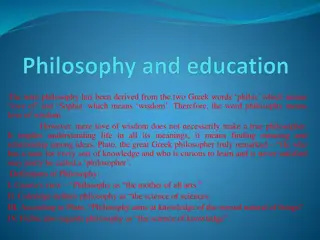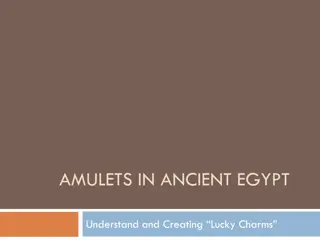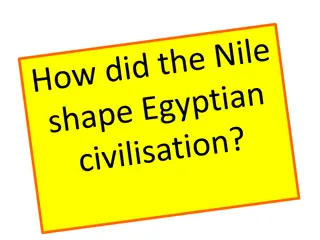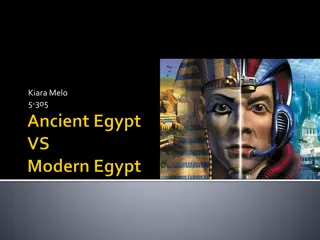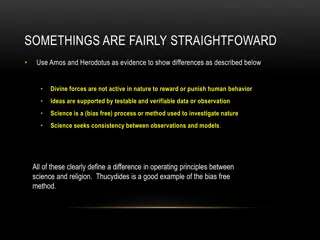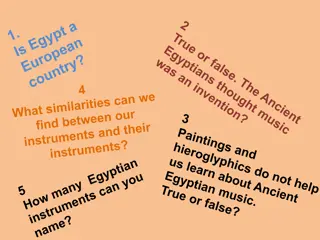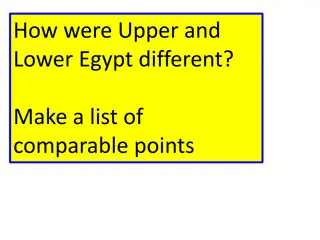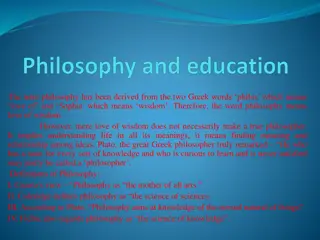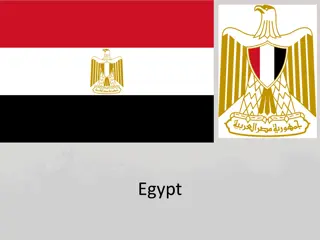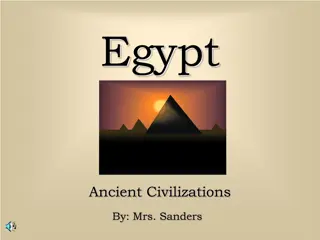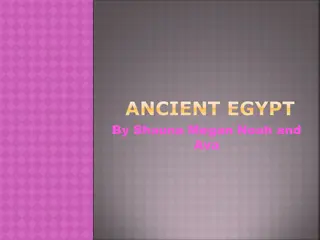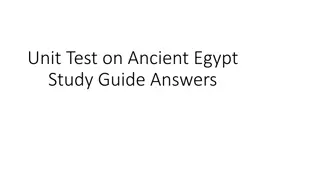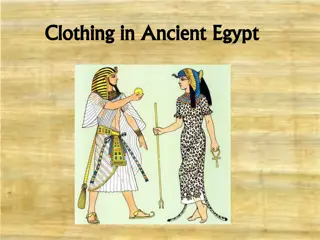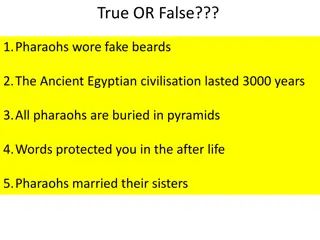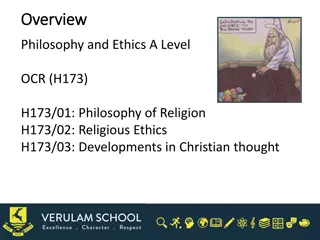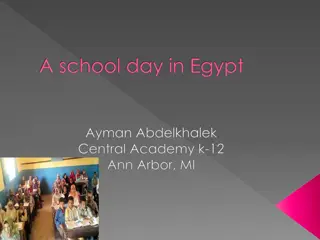Ancient Egypt Religion, Philosophy, and Medicine Overview
Explore the fascinating world of Ancient Egyptian religion, philosophy, and medicine with insights into the non-Western origins of writing, influential medical advancements, and potential impacts on the Judeo-Christian tradition. Delve into the mysteries of hieroglyphs, pyramids, and key terms like Rosetta Stone and Monotheism. Uncover ancient wisdom and practices that shaped a civilization.
Download Presentation

Please find below an Image/Link to download the presentation.
The content on the website is provided AS IS for your information and personal use only. It may not be sold, licensed, or shared on other websites without obtaining consent from the author.If you encounter any issues during the download, it is possible that the publisher has removed the file from their server.
You are allowed to download the files provided on this website for personal or commercial use, subject to the condition that they are used lawfully. All files are the property of their respective owners.
The content on the website is provided AS IS for your information and personal use only. It may not be sold, licensed, or shared on other websites without obtaining consent from the author.
E N D
Presentation Transcript
Montclair State University Department of Anthropology Anth 140: Non Western Contributions to the Western World Dr. Richard W. Franke Ancient Egypt Week 07 Lecture 03 Ancient Egypt Religion and Philosophy Medicine Last updated 19 September, 2019 Previously updated 27 March, 2017 Previously updated 12 March, 2016 3/12/2016 1
Montclair State University Department of Anthropology Anth 140: Non Western Contributions to the Western World Dr. Richard W. Franke Week 07 Ancient Egypt The learning objectives for week 07 are: to appreciate the nonwestern origins of writing and the alphabet to understand what scholars know about the ancient pyramids to know a few basic facts about life in ancient Egypt to appreciate some of the major medical advances made in ancient Egypt to understand the likely Egyptian influences on the Judeo- Christian tradition 2
Montclair State University Department of Anthropology Anth 140: Non Western Contributions to the Western World Dr. Richard W. Franke Week 07 Ancient Egypt Terms you should know for week 07 are: Hieroglyph Cartouche Rosetta Stone Kufu pyramid Monotheism (origins) 3
Montclair State University Department of Anthropology Anth 140: Non Western Contributions to the Western World Dr. Richard W. Franke Week 07 Lecture 02 Ancient Egypt and the Pyramids Sources: Allen, James P. 2005. The Art of Medicine in Ancient Egypt. New York: The Metropolitan Museum of Art and Yale University Press. Published in conjunction with the exhibition The Art of Medicine in Ancient Egypt, held at the MMA New York from September 13, 2005 to January 15, 2006 Breasted, James Henry. 1933. The Dawn of Conscience. New York: Simon & Schuster. Excerpted as Egypt s Moral Legacy: The Impact on Early Judaism. In Turning Points in World History: Ancient Egyptian Civilization, edited by Brenda Stalcup. San Diego CA: Greenwood Press, pages 196 208. Hurry, Jamieson B. 1926. Imhotep: The Vizier and Physician of King Zoser. Oxford: Oxford University Press. Mininberg, David T. 2006. Gallery lecture on The Art of Medicine in Ancient Egypt. 10 January 2006; Nunn, John F. 1996. Ancient Egyptian Medicine. Norman: University of Oklahoma Press by special arrangement with the British Museum Press. Smith, W. Stevenson. 1958. The Art and Architecture of Ancient Egypt. New Haven: Yale University Press. Trigger, B. G., B. J. Kemp, D. O Conner and A. B. Lloyd. 1983. Ancient Egypt: A Social History. Cambridge: Cambridge University Press. Zaslavsky, Claudia. 1990 [1973]. Africa Counts: Number and Pattern in African Culture. Brooklyn, New York: Lawrence Hill Books. Page 22 4
Montclair State University Department of Anthropology Anth 140: Non Western Contributions to the Western World Dr. Richard W. Franke Ancient Egyptian Religion and Philosophy Overview Osiris and Isis story Pharaohs and pyramids Influences on Judeo-Christian beliefs? Body and soul Lesser gods and goddesses 9/22/2024 5
Montclair State University Department of Anthropology Anth 140: Non Western Contributions to the Western World Dr. Richard W. Franke Ancient Egyptian Religion and Philosophy The Osiris and Isis Story Osiris, son of Amun-Ra, the sun god, was murdered by Seth, his jealous brother. Seth cut up Osiris' corpse into several (sometimes 14) pieces and scattered them across Egypt. 9/22/2024 6
Montclair State University Department of Anthropology Anth 140: Non Western Contributions to the Western World Dr. Richard W. Franke Ancient Egyptian Religion and Philosophy The Osiris and Isis Story Isis, sister and wife of Osiris, painstakingly found and reassembled the body parts, wrapped them in mummy cloth and resurrected him long enough to climb on his erect phallus and become pregnant with Horus. 9/22/2024 7
Montclair State University Department of Anthropology Anth 140: Non Western Contributions to the Western World Dr. Richard W. Franke Ancient Egyptian Religion and Philosophy The Osiris and Isis Story Osiris then became god of the night sky and of the realm of the dead. Horus eventually kills Seth to avenge the murder of Osiris. 9/22/2024 8
Montclair State University Department of Anthropology Anth 140: Non Western Contributions to the Western World Dr. Richard W. Franke Ancient Egyptian Religion and Philosophy The Osiris and Isis Story Each living pharaoh took on the identity of Horus, and became Osiris at death. A cult of worshipers of Isis became widespread for thousands of years, and was well established in Roman times. 9/22/2024 9
Montclair State University Department of Anthropology Anth 140: Non Western Contributions to the Western World Dr. Richard W. Franke Ancient Egyptian Religion and Philosophy The Osiris and Isis Story It may have influenced the development of early Christian ideas about Mary and Jesus. The Da Vinci Code novel contains speculations about the possibility that Jesus and Mary Magdalene were part of an Isis cult. 9/22/2024 10
Montclair State University Department of Anthropology Anth 140: Non Western Contributions to the Western World Dr. Richard W. Franke Ancient Egyptian Religion and Philosophy As we noted in previous slides about the pyramids pharaohs were gods as well as humans Burial in pyramids established their connection to the realm of the dead May be star connections as well 9/22/2024 11
Montclair State University Department of Anthropology Anth 140: Non Western Contributions to the Western World Dr. Richard W. Franke Ancient Egyptian Religion and Philosophy Judeo-Christian Influences? Ancient Egyptian religion is more than 1,000 years older than earliest known Judeo-Christian writings Ancient Egyptians first known culture to imagine reunification of soul with body after a period after death 9/22/2024 12
Montclair State University Department of Anthropology Anth 140: Non Western Contributions to the Western World Dr. Richard W. Franke Ancient Egyptian Religion and Philosophy Judeo-Christian Influences? Earliest known Egyptian gods/goddesses were elements of nature. Early parts of Old Testament: God as fire and/or as volcano 9/22/2024 13
Montclair State University Department of Anthropology Anth 140: Non Western Contributions to the Western World Dr. Richard W. Franke Ancient Egyptian Religion and Philosophy Judeo-Christian Influences? Egyptians among the earliest known people to develop belief in anthropomorphic (human form) gods/ goddesses. This is a major feature of the Judeo- Christian tradition: God as father, king, judge, shepard 9/22/2024 14
Montclair State University Department of Anthropology Anth 140: Non Western Contributions to the Western World Dr. Richard W. Franke Ancient Egyptian Religion and Philosophy Judeo-Christian Influences? Early Egyptian anthropomorphic deities had a transitional quality, keeping parts of animals mixed with humans. Thus the anthropomorphic god Horus often has a falcon's head. (A falcon god called Horus was also known in ancient Egypt.) 9/22/2024 15
Montclair State University Department of Anthropology Anth 140: Non Western Contributions to the Western World Dr. Richard W. Franke Ancient Egyptian Religion and Philosophy Judeo-Christian Influences? The Egyptian creation story begins with a dark, watery void, probably a reference to the Nile flood. Atum, the creator, rises out of the waters and creates all living things. The Genesis creation story two thousand years later has strikingly similar elements. 9/22/2024 16
Montclair State University Department of Anthropology Anth 140: Non Western Contributions to the Western World Dr. Richard W. Franke Ancient Egyptian Religion and Philosophy Judeo-Christian Influences? Some of Egypt's gods and goddesses came down from "heaven" to earth to perform particular tasks another possible precursor of later Christian ideas. 9/22/2024 17
Montclair State University Department of Anthropology Anth 140: Non Western Contributions to the Western World Dr. Richard W. Franke Ancient Egyptian Religion and Philosophy Soul in Ancient Egypt Egyptians developed complex ideas about soul 1. One's name 2. One's shadow 3. One's Ba the body could not visit outside the tomb which had some power of its own reflecting the ability to procreate an animating force that could fly to places 9/22/2024 18
Montclair State University Department of Anthropology Anth 140: Non Western Contributions to the Western World Dr. Richard W. Franke Soul in Ancient Egypt 4. One's Akh only after death 5. One's Ka the personality of the eternal identity of the individual; during one's life it played some role not yet well understood by modern observers. A person's tomb was known as the "house of his/her ka." a supernatural power attained the spirit after death, perhaps 9/22/2024 19
Montclair State University Department of Anthropology Anth 140: Non Western Contributions to the Western World Dr. Richard W. Franke Ancient Egyptian Religion and Philosophy Lesser gods and goddesses Egyptian religion developed and changed somewhat over the 3,000 years of its existence, so other versions of the Osiris story are found, as are other gods, goddesses, cults, and beliefs. 9/22/2024 20
Montclair State University Department of Anthropology Anth 140: Non Western Contributions to the Western World Dr. Richard W. Franke Ancient Egyptian Religion and Philosophy Lesser gods and goddesses Ptah: patron of craftsmen Thoth: patron of scribes; god of mathematics Hathor: goddess of love and childbirth Maat: goddess of truth, justice, and order; maat later became an abstract principle of truth and justice 9/22/2024 21
Montclair State University Department of Anthropology Anth 140: Non Western Contributions to the Western World Dr. Richard W. Franke Ancient Egyptian Religion and Philosophy Judeo-Christian Influences? Egypt the first culture historically to adopt monotheism In 18th dynasty in reign of pharaoh Akhenaten 9/22/2024 22
Montclair State University Department of Anthropology Anth 140: Non Western Contributions to the Western World Dr. Richard W. Franke Influences on Judeo-Christian Tradition? Reigned about 1353 BC to 1336 BC Combined Atum, Ra, and Horus into one god called Atum 9/22/2024 23
Montclair State University Department of Anthropology Anth 140: Non Western Contributions to the Western World Dr. Richard W. Franke Ancient Egyptian Religion and Philosophy Also famous because of wife Nefertiti Her bust in Berlin museum considered one of finest remains from antiquity 9/22/2024 24
Montclair State University Department of Anthropology Anth 140: Non Western Contributions to the Western World Dr. Richard W. Franke Ancient Egyptian Religion and Philosophy Influences on Judeo-Christian Tradition? Akhenaten s monotheism at least 100 years before Moses wrote down first five books of Old Testament Name Moses is Egyptian word (Moishe) for child Moses grew up and was educated in Egypt 9/22/2024 25
Montclair State University Department of Anthropology Anth 140: Non Western Contributions to the Western World Dr. Richard W. Franke Ancient Egyptian Religion and Philosophy Influences on Judeo-Christian Tradition? Passages in Book of Proverbs and other Old Testament writings virtual quotes from earlier Egyptian writings Especially from Egyptian text called Maxims of Amenemope, written 1,500 years before Bible 9/22/2024 26
Montclair State University Department of Anthropology Anth 140: Non Western Contributions to the Western World Dr. Richard W. Franke Ancient Egyptian Religion and Philosophy Influences on Judeo-Christian Tradition? More info Breasted, James Henry. 1933. The Dawn of Conscience. New York: Simon & Schuster. Excerpted as Egypt s Moral Legacy: The Impact on Early Judaism. In Turning Points in World History: Ancient Egyptian Civilization, edited by Brenda Stalcup. San Diego CA: Greenwood Press, pages 196 208. 9/22/2024 27
Montclair State University Department of Anthropology Anth 140: Non Western Contributions to the Western World Dr. Richard W. Franke Ancient Egyptian Medicine Ancient Egypt was the most medically advanced culture of its time. Many of the practices developed by Egyptian physicians, physician-priests, and magicians laid the basis for modern medicine, being passed through the Greeks and other later cultures. 9/22/2024 28
Montclair State University Department of Anthropology Anth 140: Non Western Contributions to the Western World Dr. Richard W. Franke Ancient Egyptian Medicine 1. Much of our knowledge of ancient Egyptian medicine comes from the Edwin Smith Papyrus, a document from 1600 BC that laid in various storehouses in New York for the past 100 years. 9/22/2024 29
Montclair State University Department of Anthropology Anth 140: Non Western Contributions to the Western World Dr. Richard W. Franke Ancient Egyptian Medicine Recently exhibited for the first time in centuries, it provides 48 medical cases with diagnoses and suggested cures. Sources for the next several slides: Allen, James P. 2005. The Art of Medicine in Ancient Egypt. New York: The Metropolitan Museum of Art and Yale University Press. Published in conjunction with the exhibition The Art of Medicine in Ancient Egypt, held at the MMA New York from September 13, 2005 to January 15, 2006; Mininberg, David T. 2006. Gallery lecture on The Art of Medicine in Ancient Egypt. 10 January 2006; Nunn, John F. 1996. Ancient Egyptian Medicine. Norman: University of Oklahoma Press by special arrangement with the British Museum Press. 30 9/22/2024
Montclair State University Department of Anthropology Anth 140: Non Western Contributions to the Western World Dr. Richard W. Franke Ancient Egyptian Medicine 9/22/2024 31
Montclair State University Department of Anthropology Anth 140: Non Western Contributions to the Western World Dr. Richard W. Franke Ancient Egyptian Medicine 2. Knowledge of the medicinal properties of the lotus also a sacred object in ancient Egypt. They would grind up the roots and swallow as a pain killer. Modern scientists have discovered that lotus roots contain a morphine-like substance. 9/22/2024 32
Montclair State University Department of Anthropology Anth 140: Non Western Contributions to the Western World Dr. Richard W. Franke Ancient Egyptian Medicine 3. The use of honey and of raw meat to heal wounds. Both are osmotics they suck up moisture and speed healing they both have enzymes that aid in healing, and honey has antibiotic properties. 9/22/2024 33
Montclair State University Department of Anthropology Anth 140: Non Western Contributions to the Western World Dr. Richard W. Franke Ancient Egyptian Medicine 4. Knowledge of the pain killing and sedating properties of opium itself, which the Egyptians imported. 9/22/2024 34
Montclair State University Department of Anthropology Anth 140: Non Western Contributions to the Western World Dr. Richard W. Franke Ancient Egyptian Medicine 5. Use of pomegranate seeds as a contraceptive. They turn out to contain estrogenic chemicals similar to the modern birth control pill. Glass jars for pomegranate seeds or root grounds, New Kingdom 1280 1080 BC 9/22/2024 35
Montclair State University Department of Anthropology Anth 140: Non Western Contributions to the Western World Dr. Richard W. Franke Ancient Egyptian Medicine 6. Use of ground up pomegranate roots that contain peletrin, an antiparasite. Infections and parasites were common problems for ancient Egyptians. 9/22/2024 36
Montclair State University Department of Anthropology Anth 140: Non Western Contributions to the Western World Dr. Richard W. Franke Ancient Egyptian Medicine 7. Use of lead- and copper-based black paint under the eyes to cut down on glare (just like modern baseball players). The galena (lead sulfide) also killed flies that caused river blindness a serious disease in ancient Egypt. 9/22/2024 37
Montclair State University Department of Anthropology Anth 140: Non Western Contributions to the Western World Dr. Richard W. Franke Ancient Egyptian Medicine 8. Ancient Egyptians had medical schools where doctors were trained from textbooks and took exams to get certified. 9. There were apparently several types of specialists including gastroenterologists, obgyns, dentists, nurses, pharmacists and proctologists. Several known physicians were women. 9/22/2024 38
Montclair State University Department of Anthropology Anth 140: Non Western Contributions to the Western World Dr. Richard W. Franke Ancient Egyptian Medicine 10. Perhaps because of their mummification experience, Egyptians possessed substantial anatomical knowledge and developed a detailed specialist terminology for parts of the body including various bones and internal organs. 9/22/2024 39
Montclair State University Department of Anthropology Anth 140: Non Western Contributions to the Western World Dr. Richard W. Franke Mummification 10a. 2017 Update: The ancient Peruvians developed mummification 7,000 years ago, way before the Egyptians 3,500 years ago. These two cultures independently created this means of preserving and understanding features of the human body. See the New York Times article of 23 March, 2017 about Peruvian and Egyptian mummies: https://www.nytimes.com/2017/03/23/art s/design/mummies-exhibition-american- museum-of-natural-history.html This slide was added on 27 March, 2017 40
Montclair State University Department of Anthropology Anth 140: Non Western Contributions to the Western World Dr. Richard W. Franke Mummification 10b. 2017 Update: The ancient Peruvians used their mummies in ceremonies where bringing back the ancestors was important. The Egyptians put their mummies in tombs where they were to be preserved for the eternal afterlife. Peruvian mummies See the New York Times article of 23 March, 2017 about Peruvian and Egyptian mummies: https://www.nytimes.com/2017/03/23/art s/design/mummies-exhibition-american- museum-of-natural-history.html This slide was added on 27 March, 2017 41
Montclair State University Department of Anthropology Anth 140: Non Western Contributions to the Western World Dr. Richard W. Franke Ancient Egyptian Medicine 11. The Edwin Smith Papyrus contains the first known description of the physical characteristics of the human brain. 9/22/2024 42
Montclair State University Department of Anthropology Anth 140: Non Western Contributions to the Western World Dr. Richard W. Franke Ancient Egyptian Medicine 12. Disease prevention: Ancient Egyptians were aware of the importance of washing the body with water, but they did not understand germs. Washing bowl with human feet. The bowl mimics the hieroglyph for clean and the tilt indicates that the water should be poured onto the body. 9/22/2024 43
Montclair State University Department of Anthropology Anth 140: Non Western Contributions to the Western World Dr. Richard W. Franke Ancient Egyptian Medicine 13. Egyptian physicians did not develop surgery to anywhere near the level of the ancient Native Americans (discussed earlier in the course). 9/22/2024 44
Montclair State University Department of Anthropology Anth 140: Non Western Contributions to the Western World Dr. Richard W. Franke Ancient Egyptian Medicine 14. Medicine and religion were closely connected. Many physicians were also priests and could administer chants and spells as well as ointments or powders. 15. Sekhmet was the goddess of medicine in ancient Egypt. 9/22/2024 45
Montclair State University Department of Anthropology Anth 140: Non Western Contributions to the Western World Dr. Richard W. Franke Ancient Egyptian Medicine 16. Taweret, the female hippopotamus was the guardian of women during pregnancy and childbirth. Taweret figurine, 300 BC 30 BC 9/22/2024 46
Montclair State University Department of Anthropology Anth 140: Non Western Contributions to the Western World Dr. Richard W. Franke Ancient Egyptian Medicine 17. Sources Allen, James P. 2005. The Art of Medicine in Ancient Egypt. New York: The Metropolitan Museum of Art and Yale University Press. Published in conjunction with the exhibition The Art of Medicine in Ancient Egypt, held at the MMA New York from September 13, 2005 to January 15, 2006; Mininberg, David T. 2006. Gallery lecture on The Art of Medicine in Ancient Egypt. 10 January 2006; Nunn, John F. 1996. Ancient Egyptian Medicine. Norman: University of Oklahoma Press by special arrangement with the British Museum Press. 9/22/2024 47
Montclair State University Department of Anthropology Anth 140: Non Western Contributions to the Western World Dr. Richard W. Franke Ancient Egyptian Medicine End of Week 07 Lecture 03 on Egyptian Religion Philosophy Medicine 9/22/2024 48
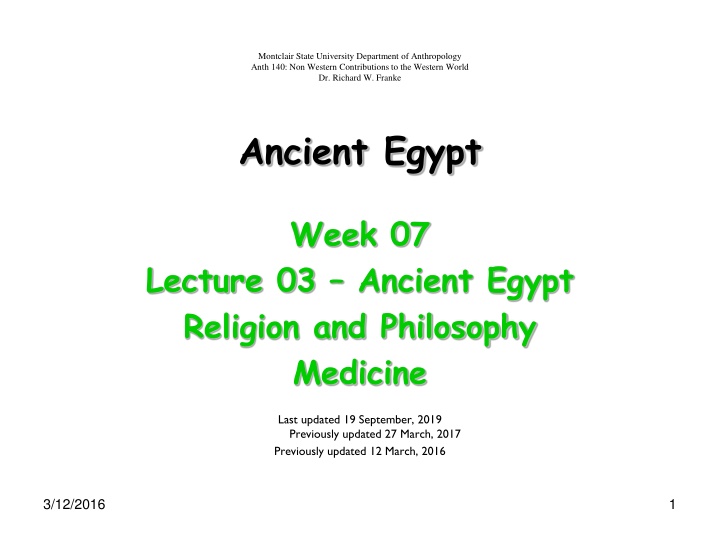

![[PDF⚡READ❤ONLINE] Tutankhamun's Trumpet: Ancient Egypt in 100 Objects from the](/thumb/20549/pdf-read-online-tutankhamun-s-trumpet-ancient-egypt-in-100-objects-from-the.jpg)
